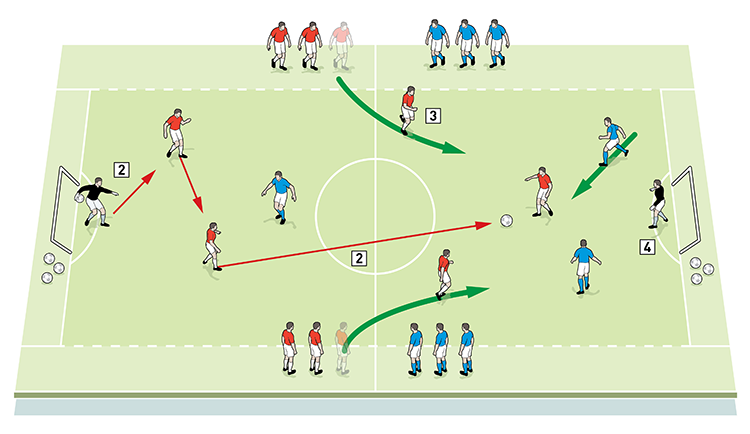Counter-attacking with an overload
Get your players attacking with pace and exploiting the space that an overload creates, then encourage them to be clinical in their finishing.

| Area | Up to full pitch |
| Equipment | Balls, bibs, cones, 2 full size goals |
| No. of Players | Up to 18 players + 2 goalkeepers |
| Session Time | Total: 40mins, Main practice: 10mins, Progression: 10mins, Game: 20mins |
This is a counter-attacking activity that we use to create 3v2 opportunities. It gets players attacking with pace and exploiting the space that the overload creates. It also encourages players to be clinical in their finishing.
Attacking players enjoy this session because it is fast and creates so many different options to score goals and exploit overload situations.
It is important for us to practise this activity, as counter-attacking is a fundamental part of our playing philosophy. It is also imperative for players to have the capacity to physically cope with repeated attacks, and also to defend in disadvantaged numbers.
What do I get the players to do?
Main practice
We set up in the space between penalty areas on a full pitch, with a goal and a goalkeeper at each end. We are using 18 outfield players split into two teams: each team starts with two defenders and a striker on the pitch, and six wide midfielders who are waiting in queues at either side of the pitch, as shown in the diagram [1].
1

2. The defenders play forward into the striker. The opposition defenders can’t challenge him until he touches the ball
3. On the striker’s first touch, an attacking player from each wing can join the striker to create a 3v2 overload
4. If the ball is lost or if a goal is scored, play restarts with the keeper and goes the other way up the pitch
The session starts with a pass from the goalkeeper to one of the two defenders. The defenders play forward to the striker, who is unopposed until his first touch of the ball. On the striker’s touch an attacking player from each wing joins the striker to create a 3v2 overload in favour of the attacking team. The attack continues until possession has been lost or a goal has been scored. Play then goes the other way up the pitch, starting with a pass from the keeper. Defenders rotate after each attack.
Play non-stop for 10 minutes and then give players three minutes to recover before embarking on the progression.
How do I progress the session?
After the first phase has been completed, you can progress the activity by adapting the rules. This time if the defenders turnover possession, they can immediately counter-attack the opposite end, with the ball being played into the striker. The two wide players can now join in straight away, without waiting for the attacker to touch the ball first.
You can further progress the activity by adding an additional striker, to make it 2v2 in each half, with the two wide attacking players supporting as before, creating a 4v2 attacking overload.
Another progression can be tried by allowing one of the previous attacking players to recover to help his defenders on the turnover of possession, making it 4v3 in favour of the new attackers.
Work on this progression for 10 minutes.
What are the key things to look out for?
After the initial ball into the forward, we would want to see the defenders realistically defending. This means closing down space, stopping the attackers turning if possible and forcing them away from goal. Defenders should be trying to dispossess the attacker or cause the attacker to play backwards. If attackers shoot, you want to see defenders anticipating and reacting to the next situation, whether that’s covering rebounds or blocking.
For the attackers, gaining good control of the ball is the key to allowing the counter-attack to progress. They must attack at pace to take advantage of the numerical supremacy, with supporting players timing the pace and angle of their runs.
In the progression, make sure forward momentum is maintained so that the supporting defenders are denied the time to recover.
How would you put this into a game situation?
Set up on a full pitch with a goal and a goalkeeper at each end. We are using 16 outfield players, making the game 8v8 plus keepers. An attacker for one team and a defender for the other team must remain in each half, as shown [2], but other than that the game is free play.
2

2. When there is a turnover in possession, the team that wins the ball must counter-attack as quickly as possible
3. The team that has won possession plays into their striker. Team mates must then join him to create an attacking overload
When there is a turnover of possession, the team that wins the ball must counter-attack as fast as possible. If the ball goes out of play, the coach can serve another ball to either team into any area of the pitch, creating counter-attacking opportunities.
Editor's Picks
Attacking transitions
Deep runs in the final third
Using the goalkeeper in build-up play
Intensive boxes drill with goals
Penetrating the final third
Creating and finishing
My philosophy
Pressing initiation
Compact team movement
Coaches' Testimonials

Alan Pardew

Arsène Wenger

Brendan Rodgers

Carlos Carvalhal

José Mourinho

Jürgen Klopp

Pep Guardiola

Roy Hodgson

Sir Alex Ferguson

Steven Gerrard
Coaches' Testimonials

Gerald Kearney, Downtown Las Vegas Soccer Club

Paul Butler, Florida, USA

Rick Shields, Springboro, USA

Tony Green, Pierrefonds Titans, Quebec, Canada
Join the world's leading coaches and managers and discover for yourself one of the best kept secrets in coaching. No other training tool on the planet is written or read by the calibre of names you’ll find in Elite Soccer.
In a recent survey 92% of subscribers said Elite Soccer makes them more confident, 89% said it makes them a more effective coach and 91% said it makes them more inspired.
Get Monthly Inspiration
All the latest techniques and approaches
Since 2010 Elite Soccer has given subscribers exclusive insight into the training ground practices of the world’s best coaches. Published in partnership with the League Managers Association we have unparalleled access to the leading lights in the English leagues, as well as a host of international managers.
Elite Soccer exclusively features sessions written by the coaches themselves. There are no observed sessions and no sessions “in the style of”, just first-hand advice delivered direct to you from the coach.









